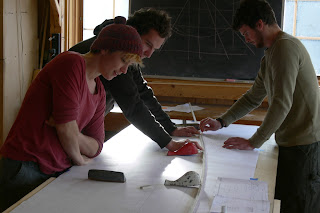For a week in early January I taught a lofting workshop at the Carpenter’s Boat Shop, a nine-month apprentice program in Pemaquid, Maine (http://www.carpentersboatshop.org/). Eleven apprentices lofted a series of small boats over the course of the week, and also built half models.
We loft on paper, using a temporary table. I find this much more convenient as I can store lofted boats by just rolling up the drawings, and working at table height is much more comfortable than on one's hands and knees.
We began by lofting a very simple flat-bottomed skiff, actually a boat that I had previously built with students in the Boat Shop’s summer class program. The skiff gave students an introduction to the principles of laying out the lines of a boat full-size, along with a sense of how the three views lofted (profile, plan, and sections) work together to provide information on construction details such as mould shapes, bevels and the stem rabbet.
From the first boat we moved on to a round-bottomed boat, which featured waterlines, buttock lines and diagonals. There, apprentices had to not only loft and fair the lines, but makes sure the lines in the three views reconciled with each other.
By Wednesday midday it seemed like a good time for a break, so we turned to the shop and students cut lifts and glued up blanks for half models. The models ranged from a Thai river boat (lines found on the internet) to the famous Herreshoff 12-1/2 sloop.
We finished the week lofting several more boats, hopefully two models that the Boat Shop may be building later this year. It was great to see the apprentices really understand the process, one that I feel is essential to anyone wanting to learn traditional boatbuilding. The ability to loft a boat opens many more resources for boatbuilders, and allows the builder to work out construction issues and pattern out many elements of a boat before building. For more about lofting, visit this page at my website: http://www.douglasbrooksboatbuilding.com/lines.html







No comments:
Post a Comment
Note: Only a member of this blog may post a comment.